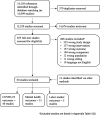Systematic review of empiric studies on lockdowns, workplace closures, and other non-pharmaceutical interventions in non-healthcare workplaces during the initial year of the COVID-19 pandemic: benefits and selected unintended consequences
- PMID: 38519891
- PMCID: PMC10960383
- DOI: 10.1186/s12889-024-18377-1
Systematic review of empiric studies on lockdowns, workplace closures, and other non-pharmaceutical interventions in non-healthcare workplaces during the initial year of the COVID-19 pandemic: benefits and selected unintended consequences
Abstract
Background: We conducted a systematic review aimed to evaluate the effects of non-pharmaceutical interventions within non-healthcare workplaces and community-level workplace closures and lockdowns on COVID-19 morbidity and mortality, selected mental disorders, and employment outcomes in workers or the general population.
Methods: The inclusion criteria included randomized controlled trials and non-randomized studies of interventions. The exclusion criteria included modeling studies. Electronic searches were conducted using MEDLINE, Embase, and other databases from January 1, 2020, through May 11, 2021. Risk of bias was assessed using the Risk of Bias in Non-Randomized Studies of Interventions (ROBINS-I) tool. Meta-analysis and sign tests were performed.
Results: A total of 60 observational studies met the inclusion criteria. There were 40 studies on COVID-19 outcomes, 15 on anxiety and depression symptoms, and five on unemployment and labor force participation. There was a paucity of studies on physical distancing, physical barriers, and symptom and temperature screening within workplaces. The sign test indicated that lockdown reduced COVID-19 incidence or case growth rate (23 studies, p < 0.001), reproduction number (11 studies, p < 0.001), and COVID-19 mortality or death growth rate (seven studies, p < 0.05) in the general population. Lockdown did not have any effect on anxiety symptoms (pooled standardized mean difference = -0.02, 95% CI: -0.06, 0.02). Lockdown had a small effect on increasing depression symptoms (pooled standardized mean difference = 0.16, 95% CI: 0.10, 0.21), but publication bias could account for the observed effect. Lockdown increased unemployment (pooled mean difference = 4.48 percentage points, 95% CI: 1.79, 7.17) and decreased labor force participation (pooled mean difference = -2.46 percentage points, 95% CI: -3.16, -1.77). The risk of bias for most of the studies on COVID-19 or employment outcomes was moderate or serious. The risk of bias for the studies on anxiety or depression symptoms was serious or critical.
Conclusions: Empiric studies indicated that lockdown reduced the impact of COVID-19, but that it had notable unwanted effects. There is a pronounced paucity of studies on the effect of interventions within still-open workplaces. It is important for countries that implement lockdown in future pandemics to consider strategies to mitigate these unintended consequences.
Systematic review registration: PROSPERO registration # CRD42020182660.
Keywords: Anxiety; COVID-19; Community mitigation; Depression; Employment; Lockdown; Non-pharmaceutical; Novel coronavirus; Social distancing; Systematic review; Workplace.
© 2024. This is a U.S. Government work and not under copyright protection in the US; foreign copyright protection may apply.
Conflict of interest statement
The authors declare that they have no competing interests.
Figures




Similar articles
-
Effectiveness of non-pharmaceutical public health interventions against COVID-19: A systematic review and meta-analysis.PLoS One. 2021 Nov 23;16(11):e0260371. doi: 10.1371/journal.pone.0260371. eCollection 2021. PLoS One. 2021. PMID: 34813628 Free PMC article.
-
Effectiveness of public health measures in reducing the incidence of covid-19, SARS-CoV-2 transmission, and covid-19 mortality: systematic review and meta-analysis.BMJ. 2021 Nov 17;375:e068302. doi: 10.1136/bmj-2021-068302. BMJ. 2021. PMID: 34789505 Free PMC article.
-
Quarantine alone or in combination with other public health measures to control COVID-19: a rapid review.Cochrane Database Syst Rev. 2020 Sep 15;9(9):CD013574. doi: 10.1002/14651858.CD013574.pub2. Cochrane Database Syst Rev. 2020. PMID: 33959956 Free PMC article.
-
Learning from previous lockdown measures and minimising harmful biopsychosocial consequences as they end: A systematic review.J Glob Health. 2021 May 22;11:05008. doi: 10.7189/jogh.11.05008. J Glob Health. 2021. PMID: 34055328 Free PMC article.
-
Physical distancing interventions and incidence of coronavirus disease 2019: natural experiment in 149 countries.BMJ. 2020 Jul 15;370:m2743. doi: 10.1136/bmj.m2743. BMJ. 2020. PMID: 32669358 Free PMC article.
Cited by
-
Artificial intelligence-based prediction of pathogen emergence and evolution in the world of synthetic biology.Microb Biotechnol. 2024 Oct;17(10):e70014. doi: 10.1111/1751-7915.70014. Microb Biotechnol. 2024. PMID: 39364593 Free PMC article. Review.
-
Multiplex Microscopy Assay for Assessment of Therapeutic and Serum Antibodies against Emerging Pathogens.Viruses. 2024 Sep 17;16(9):1473. doi: 10.3390/v16091473. Viruses. 2024. PMID: 39339949 Free PMC article.
-
Urban Air Quality Shifts in China: Application of Additive Model and Transfer Learning to Major Cities.Toxics. 2025 Apr 24;13(5):334. doi: 10.3390/toxics13050334. Toxics. 2025. PMID: 40423413 Free PMC article.
References
-
- World Health Organization: WHO Director-General's opening remarks at the media briefing on COVID-19 - 11 March 2020. https://www.who.int/director-general/speeches/detail/who-director-genera.... Accessed 29 Dec 2023.
-
- Hoehn-Velasco L, Silverio-Murillo A, Balmori de la Miyar JR: The long downturn: The impact of the great lockdown on formal employment. J Econ Bus 2021;115(May-June):105983.
Publication types
MeSH terms
LinkOut - more resources
Full Text Sources
Medical
Miscellaneous

